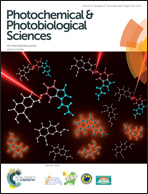Experimental and theoretical studies of spectroscopic properties of simple symmetrically substituted diphenylbuta-1,3-diyne derivatives†
Abstract
A series of symmetrically substituted diphenylbuta-1,3-diyne (DPB) derivatives possessing electron-donating (N,N-dimethylamino or methoxy) or electron-accepting (nitrile, ester or aldehyde) groups have been prepared and studied with emphasis on their spectral and photophysical properties. The photophysical characteristics of these compounds have been studied in relation to their structures and influence of solvents or temperature. The observed spectral and photophysical properties are explained with the help of potential energy maps in the ground and excited states obtained from density functional theory (DFT, B3LYP, def2TZVP basis set) calculations. The structure–property relationship of all of the compounds is discussed and compared with appropriate diphenylacetylene derivatives.


 Please wait while we load your content...
Please wait while we load your content...